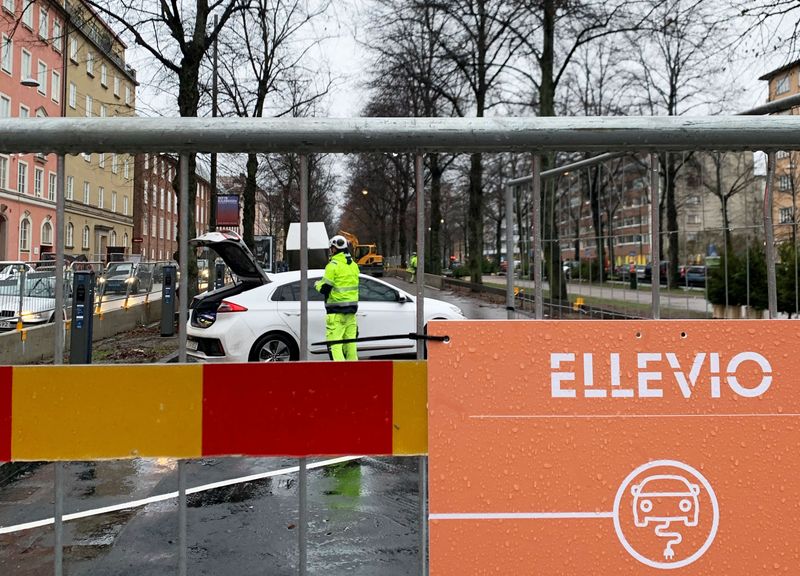LONDON/STOCKHOLM (Reuters) – A stroll down Stockholm’s longest street that takes its name from the mythical Valhalla, where Norse gods feast and fight until doomsday, gives a hint of the battle today’s power grids face to keep pace with government goals to electrify transport.
Early this month, a man selling Christmas trees looked on as workers installed 10 public vehicle charging stations with two power outlets each in Valhallavägen, which is around 3.5 kilometers (2.17 miles) long.
It’s progress, but not enough.
Sales of electric and plug-in hybrid vehicles during the first nine months of 2020 rose by 122% in the European Union, accounting for about 8% of new car sales, industry figures show.
In Sweden, electric vehicles (EVs) made up nearly 28% of the market for the first three quarters of the year, with 56,559 fully-electric or plug-in hybrids sold.
Sales of petrol and diesel cars will be banned in Sweden from 2030, so many more of the nearly 5 million passenger cars registered today will gradually be replaced by zero-emission EVs.
Kristofer Fröjd, head of business development at Ellevio, Stockholm’s power distributor, said Stockholm has fewer than 4,000 public charging stations and will require 25,000 by 2030.
Apart from the quantity, there are other issues as Sweden’s power grid is already stretched to capacity at times, especially during the peak demand winter months.
On the coldest days, operators will have to balance the demand for domestic heat – and Christmas tree lights – with transport needs, which means that within two or three years, as EV numbers climb, drivers will have to put up with slower charging at public stations.
“The grid in Sweden is robust, but it’s very, very old,” Fröjd said. “We can’t jeopardise the health of our grid.”
National transmission grid operator Svenska Kraftnät plans to spend up to 150 billion Swedish krona ($17.9 billion) rebuilding about 5,000 kilometers (3,107 miles), or roughly a third, of Sweden’s grid, by 2030.
Officials say that will not be soon enough to prevent capacity coming under strain from around 2022.
Environmental group Transport & Environment (T&E) says it is not inevitable that EVs create grid problems.
In a report in June last year, it said using old vehicle batteries for energy storage would boost capacity and that charging overnight and during off-peak hours would spread out demand.
But significant investment is still necessary.
The European Union as a whole, will require 2.9 million public chargers for up to 44 million EVs by 2030, up from 200,000 chargers at the end of 2019, at a cost of 20 billion euros ($24.30 billion), T&E estimates. A further 60 billion euros will be needed for private chargers at home.
Private investors could help. But Hannes Weckmann, a director at consultancy AlixPartners, said they are cautious because charging station use is so low for now.
Simon Webber, a portfolio manager at Schroders, which has about $650 billion in assets under management, said he is “a little bit wary” of investing because so many players, from utilities to supermarket chains, have public charging projects the risk is they will not all be profitable.
“It’s a bit unclear to me what the success of the business models will be,” Webber said.
EAST-WEST DIVIDE?
Some auto industry executives worry investment in charging will be concentrated in richer, Western member states and the difficulty of finding public charging stations in Eastern European countries will depress demand.
For automakers, that would mean having to sell more electric cars in affluent markets to meet EU-wide carbon reduction targets.
“If there’s no charging infrastructure, they’re not going to sell the cars,” said Mattias Bergman, CEO of Swedish auto industry group BIL Sweden.
Sweden has begun preparing for soaring electricity consumption, expected as data centres, heavy industry and a rising population, as well as greater EV use, increase demand by an estimated 43% by 2045 from now.
That is equivalent to one and a half times Denmark’s power use, Ellevio’s Fröjd says.
By 2045, EVs will consume nearly 10% of Sweden’s total electric power output, up from 0.4% now, Per Eckemark, Svenska Kraftnät’s grid executive manager. said.
Sweden’s challenges are echoed elsewhere in the EU and beyond.
A study published by Britain’s car lobby group in September estimated Britain alone will need 2.8 million public chargers by 2035, at a cost of 16.7 billion pounds ($22.07 billion) versus less than 20,000 today.
Jacob Briggs, a senior analyst at energy consultant Cornwall Insight, says the cost of connecting charging station depends on the capacity of the grid behind it.
“In one region you could be charged 30,000 pounds for the connection and all the capacity you need for that site, or 300,000 pounds or 3 million elsewhere,” Briggs said.
That could lead to a very uneven distribution of charging points.
Back in Stockholm, Eva Sunnerstedt, who runs Stockholm’s EV policy, said the city is working to streamline the planning process and the optimum places for chargers, but there is an element of guesswork.
“We don’t know how driver behaviour is going to evolve, so right now we’re testing this,” she said.
($1 = 0.7565 pounds)
($1 = 0.8229 euros)
($1 = 8.3844 Swedish crowns)
(Reporting By Nick Carey; editing by Barbara Lewis)



























